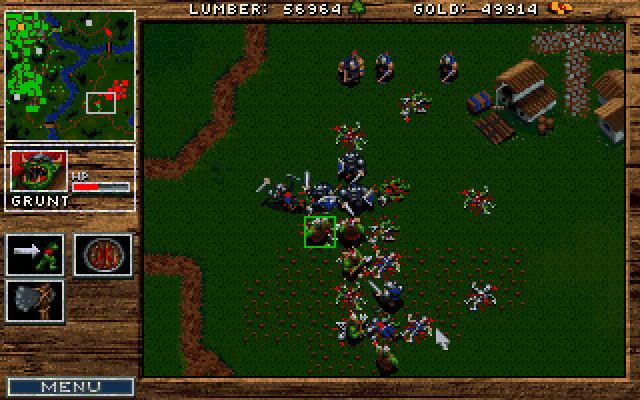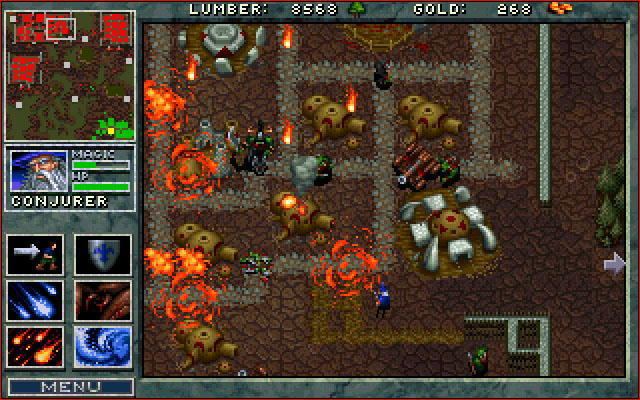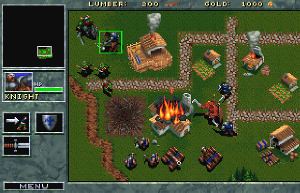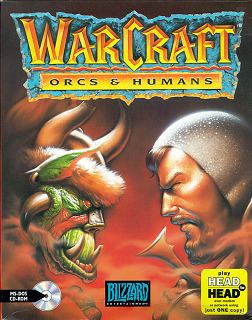9.6 /10 1 Votes
5/5 eBay Developer Blizzard Entertainment Designer Blizzard Entertainment | 4.5/5 My Abandonware Initial release date 1994 | |||||||||||||||||||||||||||||||||
 | ||||||||||||||||||||||||||||||||||
Producer(s) Bill RoperPatrick Wyatt Programmer(s) Bob FitchJesse McReynoldsMichael MorhaimePatrick Wyatt Composer(s) Gregory AlperRick JacksonChris PalmerGlenn Stafford Mode(s) Single-player, multiplayer Similar Warcraft II: Tides of Darkness, Warcraft III: Reign of Chaos, Warcraft III: The Frozen Throne, Diablo, StarCraft | ||||||||||||||||||||||||||||||||||
Warcraft: Orcs & Humans is a real-time strategy game (RTS), developed by Blizzard Entertainment and published by Blizzard and Interplay Entertainment. The MS-DOS version was released on 23 November 1994 and the Macintosh version in early 1996. Sales were fairly high, reviewers were mostly impressed, and the game won three awards and was a finalist for three others. There was a CD re-release, namely version 1.21 (CD version), that didn't have the word-from-the-user-manual copy protection of prior versions. The sequel, Warcraft II: Tides of Darkness, became the main rival to Westwood Studios' Command & Conquer series, and this competition fostered an RTS boom in the mid to late 1990s.
Contents
- Gameplay
- Modes
- Economy and power
- User interface
- Storyline
- Development and publication
- Reception
- Predecessors and innovations
- Sequels
- Blizzard style of RTS games
- References

Although Warcraft: Orcs & Humans was not the first RTS title to offer multiplayer games, Blizzard's game persuaded a wider audience that multiplayer facilities were essential for future RTS titles. The game introduced innovations in mission design and gameplay elements, which were adopted by other RTS developers.

Blizzard's main emphases in these games were on skillful management of relatively small forces and on development of characterization and storyline within and between games played in the same universe.

Gameplay

Warcraft: Orcs & Humans is a real-time strategy game (RTS). The player takes the role of either the Human inhabitants of Azeroth, or the invading Orcs. In the single player campaign mode the player works through a series of missions, the objective of which varies, but usually involves building a small town, harvesting resources, building an army and then leading it to victory. In multiplayer games, the objective is always to destroy the enemy players' forces. Some scenarios are complicated by the presence of wild monsters, but sometimes these monsters can be used as troops. The game plays in a medieval setting with fantasy elements. Both sides have melee units and ranged units, and also spellcasters.
Modes

Warcraft: Orcs & Humans's gameplay expands the Dune II "build base, build army, destroy enemy" paradigm to include other modes of game play. These include several new mission types, such as conquering rebels of the player's race, rescuing and rebuilding besieged towns, rescuing friendly forces from an enemy camp and then destroying the main enemy base, and limited-forces missions, in which neither side can make further units, and making efficient use of one's platoon is a key strategy element. In one mission, the player has to kill the Orc chief's daughter.

The game also allows two players to compete in multiplayer contests by modem or local networks, and enables gamers with the MS-DOS and Macintosh version to play each other. Multiplayer and AI skirmishes that are not part of campaigns were supported by a random map generator. The game also allowed spawn installations to be made.
Economy and power
Warcraft requires players to collect resources, and to produce buildings and units in order to defeat an opponent in combat. Non-combatant builders deliver the resources to the Town Center from mines, from which gold is dug, and forests, where wood is chopped. As both are limited resources which become exhausted during the game, players must collect them efficiently, and also retain forests as defensive walls in the early game when combat forces are small.
The lower-level buildings for Humans and Orcs have the same functions, but different sprites. The Town Hall stores resources and produces units that collect resources and construct buildings. Each Farm provides food for up to four units, and additional units cannot be produced until enough Farms are built. The Barracks produces all non-magical combat units, including melee, ranged, mounted, and siege units. However all except the most basic also need assistance from other buildings, some of which can also upgrade units.
Each side can construct two types of magical buildings, each of which produces one type of spellcaster and researches more advanced spells for that type. These advanced buildings can be constructed only with assistance from other buildings. The Human Cleric and Orc Necrolyte can both defend themselves by magic and also see distant parts of the territory for short periods. The Cleric's other spells are protective, healing the injured and making troops invisible, while the Necrolyte raises skeletons as troops and can make other units temporarily invulnerable, at the cost of severely damaging them when the spell dissipates. The Human Conjurer and Orc Warlock have energy blasts, wider-range destruction spells and the ability to summon small, venomous monsters. The Conjurer can summon a water elemental, while the Warlock can summon a demonic melee unit.
User interface
The main screen has three areas: the largest, to the right, is the part of the territory on which the player is currently operating; the top left is the minimap; and, if a building or unit(s) is selected, the bottom left shows their status and any upgrades and the actions that can be performed. The status details include a building's or unit's health, including its progress if being constructed, and any upgrades the object has completed. The Menu control, at the very bottom on the left, provides access to save game, load game and other menu functions.
Initially most of the main map and minimap are blacked out, but the visible area expands as the player's units explore the map. The mini-map shows a summary of the whole territory, with green dots for the player's buildings and units and red dots for enemy ones. The player can click in the main map or the minimap to scroll the main map around the territory.
All functions can be invoked by the mouse. Keys can also invoke the game setup, some of the menu options and some gameplay functions including scrolling and pausing the game. Players can select single units by clicking, and groups of up to four by shift-clicking or bandboxing. To move units, players can shift the mouse to select units on the main map, move to the unit menu to select an action, and then back to the main map or minimap to specify the target area; but shortcut keys can eliminate the middle mouse action in this cycle.
Storyline
The Orcs originated from another world, Draenor, where the orcs, once a peaceful race, became bloodthirsty from the blood of a pitlord. However, their Warlocks remained aloof, devoting their time to the research of magic. The Warlocks noticed a rift between the dimensions and, after many years, opened a small portal to another world. One Warlock explored and found a region, whose Human inhabitants called it "Azeroth", from which the Warlock returned with strange plants as evidence of his discovery.
The Orcs enlarged the portal until they could transport seven warriors, who massacred a Human village. The raiding party brought back samples of good food and fine worksmanship, and a report that the Humans were defenseless. The Orcs' raiding parties grew larger and bolder, until they assaulted Azeroth's principal castle. However, the Humans had been training warriors of their own, especially the mounted, heavily armed Knights. These, assisted by Human Sorcerers, gradually forced the Orcs to retreat through the portal, which the Humans had not discovered.
For the next fifteen years, one faction of Orcs demanded that the portal be closed. However a chief of exceptional cunning realized that the Humans, although out-numbered, had prevailed through the use of superior tactics, organization, and by magic. He united the clans, imposed discipline on their army and sought new magics from the Warlocks and Necromancers. Their combined forces were ready to overthrow the Humans.
Development and publication
While the earliest real-time strategy games appeared in the 1980s, and others followed in the early 1990s, Westwood Studios's Dune II, released for DOS in 1992, established the pattern of modern RTS games. Blizzard Entertainment was surprised that no further RTS titles appeared in 1993 and early 1994 – although in fact Westwood had quietly been working on Command & Conquer since the completion of Dune II. To take advantage of the lull in RTS releases, Blizzard produced Warcraft: Orcs & Humans. While later "...craft" games were famous for complex stories presented lavishly, the first member of the series had no script and was improvised in the recording studio by one of the game's producers. The contract composer Gregory Alper wrote music that Blizzard staff found reminiscent of Holst's The Planets. Demos in summer 1994 whetted appetites for the completed game, released for MS-DOS in November 1994 and for the Macintosh in 1996. The game was published by Blizzard in North America and by Interplay Entertainment in Europe, and Sold-Out Software republished the MS-DOS version in March 2002.
Reception
Warcraft: Orcs & Humans became, at the time, by far the company's greatest success to date, and for the first time made the company's finances secure. In November 1995 Entertainment Weekly reported that the game ranked 19th of the top 20 CDs across all categories.
The game was released in November 1994. Although reviews did not appear until months later, in Dragon Paul Murphy described the game as "great fun – absorbing and colorful," and Scott Love praised its solid strategy, simple interface and fantasy theme. Warcraft: Orcs & Humans won PC Gamer’s Editors' Choice Award, Computer Life’s Critics' Pick and the Innovations Award at the Consumer Electronics Show, Winter 1995. It was a finalist for Computer Gaming World’s Premier award, PC Gamer’s Strategy Game of the Year and the Academy of Interactive Arts & Sciences's Best Strategy award.
S. Love of MacWEEK found the play hard work, as often two or three of the gamer's units would attack without orders, while the rest still did nothing, and buildings could also lie idle without orders.
In a retrospective review, the J-Man of Just Games Retro said the game is overly slow, as the player must produce a few basic buildings and peasants in order to gather resources, and then start building combat units, while the enemy starts with more buildings and the ability to immediately send out offensive units to undo the player's efforts. He also criticized that the basic units of the two sides are essentially identical and that the interface is clunky, but praised the resource system and effective enemy AI.
GameSpot's retrospective on real-time strategy history said the game's AI was unintelligent and predictable, and Scott Love said a difficulty setting would have increased the game's longevity. Reviewers found the pathfinding poor. Both Scott Love and the J-Man said the game runs very slowly during large battles.
Some reviewers said the stereo sound helped gamers to locate events that occurred outside the current viewport. K. Bailey of 1UP liked units' speech effects, especially in response to repeated clicks, while Scott Love and the J-Man found this monotonous. Game Revolution’s review of the Mac version complained that Warcraft: Orcs & Humans’s graphics, which were ported from the DOS version's VGA, did not exploit the Macintosh's superior resolution. However, Game Revolution and Mac Gamer agreed that visual shortcomings did not reduce Mac gamers' enjoyment of the engrossing gameplay. Both also complained that the Macintosh was released about a year later than the DOS version. In contrast, a reviewer for Next Generation, while not overlooking the fact that Warcraft II was already out by the time the Macintosh version was released, made no criticism on this point, and asserted that "Amazingly easy to pick up and play, Warcraft still manages to offer enough challenge to keep gaming veterans happy for hour after hour. Completed by sharp graphics, and good voice acting, the only thing holding this game back at all is its somewhat limited play options ..."
Predecessors and innovations
The first RTS game was developed in the 1970s on a mainframe, and RTS for home computers appeared in the early 1980s. Dune II, released in 1992, established conventions that most subsequent RTS games followed, including the "collect resources, build base and army, destroy opponents" pattern. Warcraft: Orcs & Humans, two years later, was the next well-known RTS game, and introduced new types of missions, including conquering rebels of the player's race and limited-forces missions, in which neither side could make further units. It also included skirmishes which were single-player games that were not part of a larger campaign. To support multiplayer and skirmishes, Warcraft: Orcs & Humans used a random map generator, a feature previously seen in the turn-based strategy game Civilization. In 1995 Westwood's RTS Command & Conquer series adopted the use of non-standard mission types and skirmishes, and Microsoft's Age of Empires included these features and a random map generator in 1997.
Modem Wars, released in 1988 for DOS and the Commodore 64, was the first RTS with multiplayer games by means of modems. Warcraft: Orcs & Humans, which allow two gamers to compete by modem or local networks, persuaded a wider audience that multiplayer competition was much more challenging than contests against the artificial intelligence (AI), and made multiplayer facilities essential for future RTS titles.
Realms, released in 1991 for DOS, Amiga and Atari ST, had a medieval theme, with melee and ranged units, and allowed gamers to resolve combat automatically or in a RTS-type style. Warcraft: Orcs & Humans was the first typical RTS to be presented in a medieval setting, and its units included spellcasters as well as melee and ranged units.
Sequels
The success of Warcraft: Orcs & Humans motivated Blizzard to publish a sequel, Warcraft II: Tides of Darkness, in December 1995, and an expansion pack, Warcraft II: Beyond the Dark Portal, in 1996. In autumn 1995 Westwood had released Command & Conquer, and the competition between these two sequels made the RTS genre popular, and defined the genre. Blizzard's new game's enhancements included: naval and air units, supported by new buildings and a new resource, oil; excellent artwork rendered in SVGA graphics; improved sound including additional responses from units; a much better AI; and new mechanisms such as patroling (moving continuously along a route for surveillance or defense). A further generation of the Warcraft: Orcs & Humans lineage, called Warcraft III: Reign of Chaos, was released in July 2002, and gained instant and enduring acclaim with both critics and players.
In April 1998 Blizzard released StarCraft, an RTS with the concepts and mechanisms of Warcraft but an interplanetary setting and three totally different races. Starcraft and its expansion StarCraft: Brood War were well received by critics, and became very successful. World of Warcraft, released in North America in November 2004 and in Europe in February 2005, was Blizzard's first attempt at a massively multiplayer online role-playing game, and used the universe of the Warcraft RTS games, including characters that first appeared in Warcraft: Orcs & Humans. WoW was praised highly by critics, was the most popular MMORPG in 2008, and in 2007 became the most profitable video game ever created.
Beyond video games, Warcraft franchises include board games, card games, books, and comics.
Blizzard style of RTS games
Warcraft: Orcs & Humans was a moderate critical and commercial success, and laid the ground for Blizzard's style of RTS, in which personality was a distinctive element. The increasingly humorous responses to clicking a unit repeatedly became a trademark of the company. Warcraft: Orcs & Humans introduced characters that also appeared in the enormously successful massively multiplayer online role-playing game World of Warcraft. The company's manuals presented detailed backstories and artwork. StarCraft used a futuristic theme, but placed the same emphasis on characterization. In all the Blizzard RTS games and in World of Warcraft, units must be managed carefully, rather than treated as expendable hordes. Blizzard has produced fewer expansion packs than Westwood, but integrated the story of each with its predecessors.
